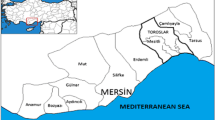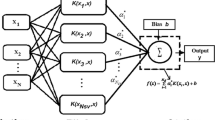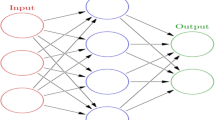Abstract
Two different artificial neural network (ANN) techniques, multi-layer perceptrons (MLP) and radial basis neural networks (RBNN), are employed in the estimation of monthly pan evaporation. The monthly climatic data, air temperature, solar radiation, wind speed, pressure and humidity, of three stations operated by the U.S. Environmental Protection Agency in California are used as inputs to the ANN models to estimate monthly evaporation. In the first part of the study, the accuracy of MLP and RBNN are compared with each other. The multi-linear regression (MLR) and the Stephens–Stewart (SS) methods are also considered for the comparison. The concern of second part of the study is to investigate the ability of neural computing techniques, MLR and SS models in evaporation estimation using data from nearby station(s). The performances of the models are evaluated using mean square errors, mean absolute relative errors and determination coefficient (R 2). The effect of periodicity on model’s estimation performance is also investigated. Based on the comparisons, it is found that the MLP and RBNN computing techniques could be employed successfully in modeling monthly evaporation process.









Similar content being viewed by others
References
Bayazıt M, Oguz B (1998) Probability and statistics for engineers. Birsen Publishing House, Istanbul, p 159
Broomhead D, Lowe D (1988) Multivariable functional interpolation and adaptive networks. Complex Syst 2(6):321–355
Bruton JM, McClendon RW, Hoogenboom G (2000) Estimating daily pan evaporation with artificial neural networks. Trans Am Soc Agricult Eng 43(2):491–496
Burman RD (1976) Intercontinental comparison of evaporation estimates. ASCE J Irrig Drain Eng 102(1):109–118
Cigizoglu HK, Kisi O (2005) Flow prediction by three back propagation techniques using k-fold partitioning of neural network training data. Nord Hydrol 36(1):49–64
Cigizoglu HK, Kisi O (2006) Methods to improve the neural network performance in suspended sediment estimation. J Hydrol 317(3–4):221–238
Clayton LH (1989) Prediction of class A pan evaporation in south Idaho. ASCE J Irrig Drain Eng 115(2):166–171
Coulibaly P, Anctil F, Bobe′e B (1999) Pre′vision hydrologique par re′seaux de neurones artificiels: e′tat de l’art. Can J Civil Eng 26(3):293–304
Coulomb CV, Legesse D, Gasse F, Travi Y, Chernet T (2001) Lake evaporation estimates in tropical Africa (Lake Ziway, Ethiopia). J Hydrol 245(1–4):1–18
Cybenco G (1989) Approximation by superposition of a sigmoidal function. Math Control Signals Syst 2(4):303–314
Dawson WC, Wilby R (1998) An artificial neural network approach to rainfall-runoff modelling. Hydrol Sci J 43(1):47–66
Gavin H, Agnew CA (2004) Modelling actual, reference and equilibrium evaporation from a temperate wet grassland. Hydrol Process 18(2):229–246
Hagan MT, Menhaj MB (1994) Training feed forward networks with the Marquardt algorithm. IEEE Trans Neural Netw 5(6):861–867
Haykin S (1998) Neural networks—a comprehensive foundation, 2nd edn. Prentice-Hall, Upper Saddle River, NJ, pp 26–32
Irmak S, Haman D, Jones JW (2002) Evaluation of class ‘A’ pan coefficients for estimating reference evapotranspiration in a humid location. J Irrig Drain Eng ASCE 128(3):153–159
Karunanithi N, Grenney WJ, Whitley D, Bovee K (1994) Neural networks for river flow prediction. J Comp Civil Eng ASCE 8(2):201–220
Keskin ME, Terzi O (2006) Artificial neural network models of daily pan evaporation. ASCE J Hydrol Eng 11(1):65–70
Kisi O (2004a) River flow modelling using artificial neural networks. ASCE J Hydrol Eng 9(1):60–63
Kisi O (2004b) Multi-layer perceptrons with Levenberg-Marquardt training algorithm for suspended sediment concentration prediction and estimation. Hydrol Sci J 49(6):1025–1040
Kisi O (2005a) Suspended sediment estimation using neuro-fuzzy and neural network approaches. Hydrol Sci J 50(4):683–696
Kisi O (2005b) Daily river flow forecasting using artificial neural networks and auto-regressive models. Turk J Eng Environ Sci 29(1):9–20
Kumar DN, Raju KS, Sathish T (2004) River flow forecasting using recurrent neural networks. Wat Res Manag 18(2):143–161
Landeras G, Ortiz-Barredo A, López JJ (2008) Comparison of artificial neural network models and empirical and semi-empirical equations for daily reference evapotranspiration estimation in the Basque Country (Northern Spain). Agric Water Manage 95(5):553–565
Lee GC, Chang SH (2003) Radial basis Radial basis function networks applied to DNBR calculation in digital core protection systems. Ann Nucl Energy 30:1561–1572
Marquardt D (1963) An algorithm for least squares estimation of non-linear parameters. J Soc Ind Appl Math 11(2):431–441
Reis RJ, Dias NL (1998) Multi-season lake evaporation: energy-budget estimates and CRLE model assessment with limited meteorological observations. J Hydrol 208(3–4):135–147
Stephens JC, Stewart EH (1963) A comparison of procedures for computing evaporation and evapotranspiration. Publication 62, International Association of Scientific Hydrology. International Union of Geodynamics and Geophysics, Berkeley, CA, 123-133
Sudheer KP, Gosain AK, Rangan DM, Saheb SM (2002) Modelling evaporation using an artificial neural network algorithm. Hydrol Process 16(16):3189–3202
Sudheer KP, Gosain AK, Ramasastri KS (2003) Estimating actual evapotranspiration from limited climatic data using neural computing technique. J Irrig Drain Eng 129(3):214–218
Supharatid S (2003) Application of a neural network model in establishing a stage–discharge relationship for a tidal river. Hydrol Process 17(15):3085–3099
Tan SBK, Shuy EB, Chua LHC (2007) Modelling hourly and daily open-water evaporation rates in areas with an equatorial climate. Hydrol Process 21(4):486–499
Tayfur G (2002) Artificial neural networks for sheet sediment transport. Hydrol Sci J 47(6):879–892
Toprak ZF, Cigizoglu HK (2008) Predicting longitudinal dispersion coefficient in natural streams by artificial intelligence methods. Hydrol Process 22(20):4106–4129
Trajkovic S (2005) Temperature-based approaches for estimating reference evapotranspiration. J Irrig Drain Eng 131(4):316–323
Trajkovic S, Stankovic M, Todorovic B (2000) Estimation of FAO Blaney–Criddle b factor by RBF network. J Irrig Drain Eng 126(4):268–270
Trajkovic S, Todorovic B, Stankovic M (2003) Forecasting of reference evapotranspiration by artificial neural networks. J Irrig Drain Eng 129(6):454–457
Xing Z, Chow L, Meng F, Rees HW, Monteith J, Lionel S (2008) Testing Reference Evapotranspiration Estimation Methods Using Evaporation Pan and Modeling in Maritime Region of Canada. J Irrig and Drain Eng 134(4):417–424
Acknowledgments
The data used in this study were downloaded from the U.S. EPA web server. The author wishes to thank the staffs of the U.S. EPA who are associated with data observation, processing, and management of U.S. EPA web sites.
Author information
Authors and Affiliations
Corresponding author
Additional information
Communicated by S. Azam-Ali.
Rights and permissions
About this article
Cite this article
Kişi, Ö. Modeling monthly evaporation using two different neural computing techniques. Irrig Sci 27, 417–430 (2009). https://doi.org/10.1007/s00271-009-0158-z
Received:
Accepted:
Published:
Issue Date:
DOI: https://doi.org/10.1007/s00271-009-0158-z




